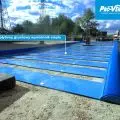Aleksandra Stępniowska, a second-year architecture student at the Wroclaw University of Technology, designed an elementary school in Lesnica, a quiet and wooded Wroclaw neighborhood. The design inspiration came from a child's drawing of the sun - a large center and rays diverging from it. From the development of a simple layout, an ecological building surrounded by greenery, powered by solar energy and managing rainwater was created.
The project, called Sun School, was created as part of the "Design of Basic Services in the City" class in the fourth semester of architecture, under the direction of Dr. Paul Horn. The school proposed by the student was designed for a plot of land in Lesnica, Wroclaw, and the audience was to be 120 students aged 7 to 15 and educators.
The plan of the school is inspired by a drawing of the sun
© Aleksandra Stępniowska
drawing of the sun
The idea of the project is the sun, familiar to us from children's drawings. A large center and rays diverging from it. In each of them there was room for a different function - administration, sports block, junior children's department. This type of division creates comfortable conditions for both work and study and promotes acoustic insulation," says Aleksandra Stępniowska.
All the rays are connected by a center on a circular plan. The young architect envisioned it as a common space with an assembly hall and tables and poufs. It is meant to be a center for meetings, relaxation and a place to spend breaks. The whole is complemented by theatrical effects caused by skylights and a sundial - so that learning the seasons and the clock will no longer be problematic.
The center of the school is the auditorium
© Aleksandra Stępniowska
classrooms in "sunshine"
Thesimple layout and separation of functions are expected to benefit children's development. The location of classrooms in the sunshine allows them to receive adequate light. The proposed form provides transparency, a sense of security and promotes the building of interpersonal relationships. The attractiveness of the layout is also related to the location of sanitary facilities. In schools, they are often the place where conflicts flare up. Here they are all located at the entrances to the rays. Each toilet serves its own ray, the number and diversity of its users are correspondingly limited.
The clear layout is conducive to the functioning of the school
© Aleksandra Stępniowska
rain gardens
Between the rays you will find green spaces that serve as rain gardens. The form of the building ensures that they are sheltered from the wind and create spaces ideal for playing during breaks. The single-story building does not pose a hindrance to the disabled and blends in with the surroundings. It also succeeds by lowering the level of the gymnasium.
Supporting the reinforced concrete structure are numerous columns
© Aleksandra Stępniowska
A simple functional scheme allowed the author to design the building with a reinforced concrete structure. Supporting the structure are the columns she used, which serve as supports. Their placement was particularly important in the central part with skylights and a sundial.
On the other hand, photovoltaic panels were placed on the roof of the building, thus obtaining a "Sun powered by the sun". - adds the student.
Sloping, flat roofs collect rainwater
© Aleksandra Stępniowska
rainwater function
The appearance of a building largely depends on water runoff. The sloping, flat roofs with local depressions are designed to collect rain water and slow down its flow, then through drains placed in columns it is discharged into underground tanks, where it is treated through simple filters and used in sanitary facilities. Provision is also made for secondary use of gray water. It will be treated and used for irrigation of green areas.
Wooden facade panels refer to the waves
© Aleksandra Stępniowska
The form's dependence on water was emphasized through the building's facade. The wooden panels were arranged in the likeness of a wave. They are movable - they act as blinds if needed.
My goal was to create not only a place for education, but above all a space that encourages development, open to all children with different needs. I wanted to provide a space for them to learn, develop their interests and relationships, but without giving up their sense of security. I believe that a school can provide positive emotions, and that's the kind of place I tried to create," concludes Aleksandra Stępniowska.
Read also about the Birch School project made in the same classes by Wojciech Bandyk and Krystian Cięciwa.








































